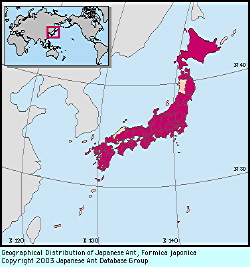
|
species
|
Formica japonica
|
 |
Japanese Name
|
Kuroyama-ari
|
Original Reference
|
|
Motschoulsky, V. de. (1866) Catalogue des insectes re?us du Japon. Bulletin de la Soci?t? Imp?riale des Naturalistes de Moscou 39: 163-200.
|
Synonym
|
|
Formica japonica Motschoulsky, 1866,
Formica fusca var. nipponensis Forel, 1900,
Formica fusca var. japonica: Emery, 1909,
Formica fusca japonica: Emery, 1925,
Formica japonica: Dlussky, 1967,
|
Description
|
|
Total length of workers 4.5 - 6 mm. Body color greyish black or brownish black. The most dully colored of Japanese Serviformica species. Very similar to Formica hayashi (Japanese name: Hayashi-kuroyama-ari), but distinguished by the usual presence of 10 or more erect setae on the second gastral tergite (the average 13), and by the dorsum of the first gastral tergite usually bearing a few erect setae (averaging 4, but lacking in some cases).
|
Remarks
|
|
Common in lowlands and open mountainous regions all over Japan. This species nests in the soil. Its nests open directly at the ground surface and are nearly vertical, with a depth of 1 - 2 m. The number of workers in a colony may reach 16,000 (Kondoh, 1968a; Yamauchi & Suzuki, 1987). Sexual alates fly during early June to mid July in Tokyo (Kawai, 1942) and from August to September in Kochi (Okamoto, 1957). Pseudogynes are found in some colonies (Sonobe, 1974). Known inquilines are a histerid beetle, Hetaerius gratus Lewis (Kubota, 1965) and a short-winged mold beetle, Kigatrodes gracilis (Sharp) (Sawada, 1974). Chromosome number 2n=54 (Imai & Yosida, 1964). There are three larval instars in the males (Imai, 1965).
|
|

Distribution
|
|
Hokkaido, Honshu, Shikoku, Kyushu, Yaku I.; Sakhalin, Kuril Is, east Siberia, Mongolia, Mainland China, Korean Peninsula, Taiwan.
|
|
References
|
|
- Catalogue des insectes re?us du Japon. Bulletin de la Soci?t? Imp?riale des Naturalistes de Moscou 39: 163-200.
- Forel, A. (1900). Fourmis du Japon. Nids en toile. Strongylognathus Huberi et voisins. Fourmiliere triple. Cyphomyrmex Wheeleri. Fourmis importees. . Mitt. Schweiz. Ent. Ges., 10, 267-287.
- Emery, C. 1909. Beitr?ge zur Monographie der Formiciden des pal?arktischen Faunengebietes. (Hym.) Teil VII. Dtsch. Entomol. Z., 1909: 179-204.
- Dlussky, G. M. 1967. Myravji roda Formica. [in Russian]. 236 pp. Nauka Publishing House, Moskva.
- Kondoh, M. (1968a. ). Bioeconomic studies on the colony of an ant species Formica japonica Motschulsky 1. Nest structure and seasonal change of the colony members. . Jpn. J. Ecol., 18, 124-133.
- Yamauchi, K. & K. Suzuki (1987). Colony structure and internest relation in Formica (Serviformica) japonica Motschulsky. . Sci. Rep. Fac. Educ.Gifu Univ. (Nat. Sci), 11, 12-17. .
- Kawai, M. (1942). Some observations of ants from Tokyo. . Entomological World , 10(95), 1-16. .
- Okamoto, H. (1957). Ants from Shikoku, Japan (4). . Gensei, 5, 39-43. .
- Sonobe, R. (1974). On the occurrence of pseudogyne of Formica japonica Motschulsky (Hymeoptera, Formicidae) in Japan. . Kontyu, 42, 401-403.
- Kubota, M. (1965). Notes on the Japanese Hetaerius Er. . Ari , (1), 1.
|
Editor
|
|
Original text by Rikio Sonobe and Keiichi Onoyama. English translation by Keiichi Onoyama, edited by Robert W. Taylor. Revised by Masashi Yoshimura.
|
|